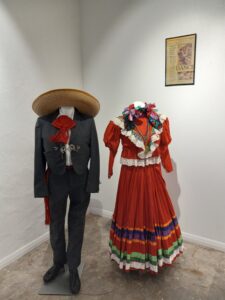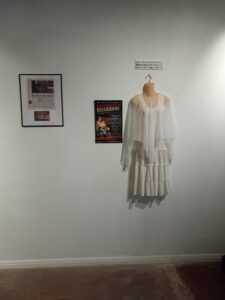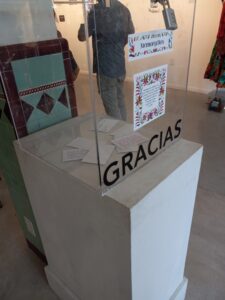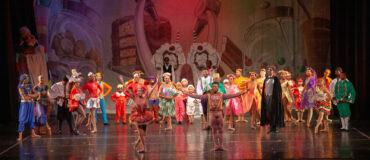By Tere Elizalde
Tere Elizalde was a 2022 Archiving and Preservation Fellow with Guadalupe Cultural Arts Center/Guadalupe Dance Company. Read more about the Fellowships here. This is the fourth and final part of Tere’s blog. Read the third part here and the first here.
November 21, 2022: “Good Practices”
This last month gave me the opportunity to gain experience in an exciting new activity using archival materials. I was able to assist the Dance Department in creating an exhibition for the thirty year anniversary of the Guadalupe Dance Company featuring materials found in the Guadalupe Cultural Arts Center (GCAC) archive. The Dance Company is under the direction of Connie Espinoza, who I have been teaching about archival work, and I have also worked with apprentices to the company, Gianna Puente and Lourdes Zavala, with additional insight from Education Director Belinda Menchaca and Dance Director Jeannette Chavez.

Male and female costumes from the Guadalupe Dance Company’s early history with a framed copy of article David Gonzales brought about the GDC’s first performance.
Connie and I collaborated on the overall design of the exhibition, which was hosted in one of the GCAC campus buildings through the end of a dance symposium in October. Important to Connie was establishing a chronology of the highlights of the company’s achievements over the years. Through our discussions on the design and gathering of materials, we had certain key factors to consider such as how to safely showcase the materials, how to showcase thirty years within the physical space and resources available to us, what types of materials to show, and what sort of interactive elements to include. Something that we were both interested in was to find a way for visitors to share their memories of the Dance Company, which could eventually be added to the archive. We included a copy of David Gonzalez’s article marking the debut performance of the Dance Company, placed alongside some of the company’s earliest costumes.
In gathering materials for the exhibition, I discovered more stories of the company for the archive including photographs and newspaper clippings. Looking over them with Belinda and Jeannette, I was able to learn more about the people who contributed to the company, such as former maestros that taught them their dances, and saw the different studios used for their classes before their current location.
I got to hear about other productions, collaborations, and performances by the Guadalupe Dance Company in recent years that highlight the diversity of their repertoire. While folklórico is featured predominantly, they have extensive experience and skill in flamenco work. Several productions such as Santuarios and Historias y Recuerdos, were opportunities for the dance company to contribute and create their own choreography and production. I especially enjoyed seeing the different materials for Historias y Recuerdos, a production centered on the stories of those in the community, expressed through images and dance choreographed by the company.

Several objects centered on Historias y Recuerdos at the onsite exhibition of the Guadalupe Dance Company, with (left to right) a copy of a newspaper review, a poster, and a costume worn during one of the performances from the GCAC Archive.
Although we could not use everything in the collection for the current exhibit, going through the collection was helpful to confirm memories with dates and names. It was also a reminder that there are many approaches or items one can use when curating an exhibition, and many ideas for new ones. In gathering materials, we had several options to showcase the company’s extensive work with flamenco, such as newspaper articles, postcards, photographs, and more for Alma de Mujer, a flamenco production the Guadalupe Dance Company performed in collaboration with Denise Guerra.
Seeing it all put together at the opening of the exhibition was a great way to see how people can interact with archives. People of different backgrounds interacted with the exhibit. There were young students about to begin classes and members of the dance company and the center reminiscing as they walked through. Visitors began to write a few thoughts for our Memory Box, and others delighted at the colorful costumes interspersed with photographs, newspapers, and posters of past productions. While it was our first time planning an exhibition, all of these types of interactions gave us ideas about future projects, from thinking about student visits to first-time researchers, to what types of archival materials could be displayed next time.
Throughout this summer, I’ve had many opportunities to learn from so many people while working with the GCAC Archive collection. From the Dance Department Staff at the center such as Belinda Menchaca, Jeannette Chavez, and Connie Espinoza, to local archivists at the UTSA Special Collections, to those at Dance/USA, and to many more in the local San Antonio community and among those engaged in dance archives.

Beginning of the Memory Box with several handwritten cards filled out by visitors.
This experience taught me much more than inventory and preservation, although I spent much time thinking about and implementing measures to address these areas in archiving. One key takeaway was the importance of perspective in archiving and how that can shape problem-solving. When I began my Fellowship, I was most familiar with standards or ideals in the field, otherwise known as the “best practices” perspective, but they are not always the most practical. Through speaking and listening to staff, archivists in different settings, and other individuals, I quickly realized that certain methods are not feasible to implement right now, or perhaps not even for a long time.
As I move forward in this field, I’d like to shift to what some are now calling “good practices,” where other perspectives found in community archiving, dance archives, and more, offer practical and innovative solutions to archiving that may not be perfectly aligned with the best practices perspectives, but follow them in feasible ways and are adaptable to the circumstances. Good practices allow us all to keep moving forward when time is critical, especially for dance archives that hold materials in different formats that may be lost. When I worked with staff in finding a stable location for their physical collection, neither the temperature nor the humidity would be following the recommended standard, but their materials are safe, accessible, and protected from the elements. Through discussion, they also have a new perspective of what it means to keep these records in better condition for the future as well. Others offered solutions for ways to share and save digital content that considered cost, format, and accessibility to others, that gave me insight on ways I never considered.
I am incredibly grateful to Dance/USA and the Guadalupe Cultural Arts Center for providing me with the opportunity to engage, reflect, and learn about archives and preservation, to interact with some amazing people and materials at the center showcasing its rich history, while contributing to the launch and continued development of GCAC’s archive.
All photos courtesy of the author.
 Tere Elizalde is pursuing a master’s degree in information science at the University of Michigan’s School of Information, focusing on Digital Archives, Library Science, and Preservation. Prior to studying archives, she obtained her MA in International and Regional Studies from the University of Michigan in 2021.
Tere Elizalde is pursuing a master’s degree in information science at the University of Michigan’s School of Information, focusing on Digital Archives, Library Science, and Preservation. Prior to studying archives, she obtained her MA in International and Regional Studies from the University of Michigan in 2021.
Drawn to how history impacts people’s way of interacting and understanding information, she sought out archives as a way to engage with underrepresented communities and increase their visibility and stories in collections to reshape societal narratives about history.
Currently working at the Bentley Historical Library as a Reference Assistant, she gets to experience and understand how various audiences interact with archives, and uses it to inform her archival practice.
Tere is looking forward to bringing her past and current experiences in research, reference, preservation, and community engagement to work alongside the Guadalupe Cultural Arts Center this summer to begin the process of creating a sustainable and community-accessible archive that features the center’s rich and cultural engagement with dance.
____
We accept submissions on topics relevant to the field: advocacy, artistic issues, arts policy, community building, development, employment, engagement, touring, and other topics that deal with the business of dance. We cannot publish criticism, single-company season announcements, and single-company or single artist profiles. Additionally, we welcome feedback on articles. If you have a topic that you would like to see addressed or feedback, please contact communications@danceusa.org.
Disclaimer: Opinions expressed in guest posts do not necessarily represent the viewpoints of Dance/USA.





